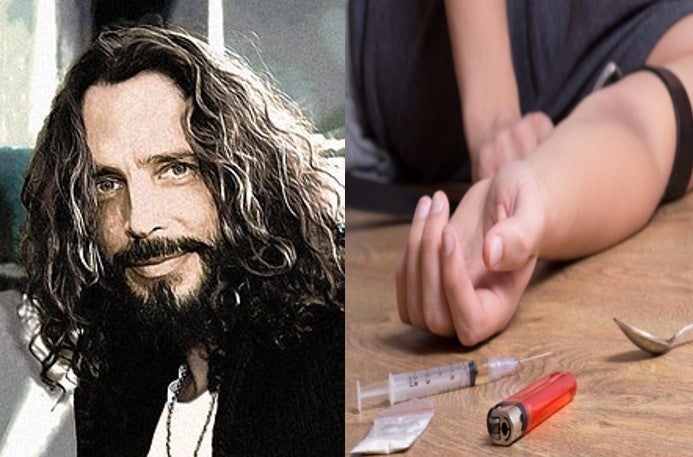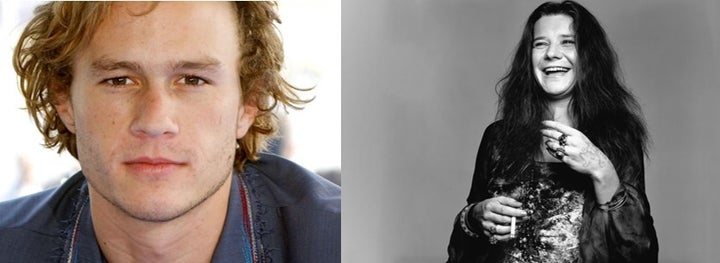
The brilliant lead singer of Soundgarden, Mr. Chris Cornell.
In August 1993, I anxiously awaited the opening acts, Soundgarden and Pearl Jam, at Toronto’s crowded Canadian National Exhibition. The headliner was Neil Young, but as a young female undergrad, I was enamored by the long brown hair, blue eyes and tenaciously pure voice of Chris Cornell. Over the next two decades, I grew to admire Cornell not only for his musicianship but his ‘groundedness’. Like his grunge brother, Eddie Vedder, Cornell had a solid head on his shoulders: married, kids, role model. ‘He would never succumb to the pitfalls of the “rock ‘n roll lifestyle” that had befallen his other grunge brother, Kurt Cobain,’ I told myself. No, musicians whose artistry transcended their profession – like Prince – are not vulnerable to the seedy, syringe-infested underbelly of rock ‘n roll. I was wrong.
Today, August 31st, 2017, is International Overdose Awareness Day. As a physician and addiction medicine specialist, I have a far better understanding of drug use today than I did as a college youth. I didn’t know then that addiction is a complex medical and psychosocial condition. A disease of the brain. The common thread weaving through almost all drug and alcohol users? It’s not a moral weakness or failing, but rather pain and suffering.
While the specific details behind the deaths of Cornell, Prince, Whitney Houston and Philip Seymour Hoffman differed, the shared theme is almost always pain: physical (e.g. hip pain) or psychological (depression, anxiety, trauma). Sometimes both. When I first moved to New York City, one of the Manhattan district attorneys and narcotics authorities was relieved that an “expert” like me was going to “combat” the city’s opioid crisis and “cure addiction.”
Initially flattered, I shook my head and ruefully replied, “As long as human beings exist, pain and suffering will exist. And as long as pain and suffering exist, men and women will find a way to relieve that pain and suffering.” Substances like heroin, prescription pills and alcohol simply numb the pain. Always have, always will.
Overdose Doesn’t Just Affect the Rich and Famous

Heath Ledger and Janice Joplin. Both died at age 27 from drug overdose.
Celebrities who fatally overdose such as Heath Ledger and Janice Joplin make front-page news. But we all know that addiction isn’t limited to the Hollywood Walk of Fame. What about the 120 people in the U.S. who die of drug overdose daily? Among them my 23-year-old patient, found on her kitchen floor by her boyfriend (also my patient), needle in her arm, drug paraphernalia scattered around her cold, frail body. Her life of struggle – her single mom used cocaine, her uncle molested her, her suicide attempts and self-medication with vodka and Vicodin – did not make any headlines.
Veterans and Opioids

Nor did that of Gary, a 45-year-old former patient, and veteran of the U.S. army. After completing his foreign deployment and returning state-side, he struggled to find a job. “The skills I learned in the army just weren’t needed back home.” Injuries endured in the military resulting in persistent low back pain placed him on disability. Years of frustration, isolation and anger led to profound depression, guilt and shame. “I come from a long line of war heroes,” Gary once told me in clinic. “The idea that I would need heroin to function was unheard of.” A week later, he was found unresponsive on the bathroom floor of his local community center. Opioid-induced respiratory arrest.
Gary’s story reflects a larger epidemic among veterans. According to the Department of Veteran Affairs (VA), 20 veterans kill themselves per day. Chronic pain, heart disease, PTSD, depression, sleep apnea, COPD – and these are just the medical and mental health problems. Add on unemployment and homelessness, and the hill of helplessness becomes an Everest of obstacles.
Opioids, International Impact and Incarceration
While the opioid crisis is creating havoc for American families – the U.S. makes up 5% of the world’s population but consumes 80% of the global opioid supply – drug overdose is not just a national problem. According to the United Nations Office of Drugs and Crime, 5% of the global adult population used drugs at least once in 2015; among this group, nearly 30 million suffer from substance use disorders. That is, their drug use is harmful to the point where they become physically dependent and need treatment. Life-saving treatment to which very few have access.
Instead, the largest addiction and mental health facilities in the U.S. are jails and prisons. The U.S. only makes up 5% of the world’s total population, but 25% of the its incarcerated population. At New York’s Rikers Island, where I oversaw addiction treatment and recovery services, over 50% of the people behind bars experience substance use issues. In other parts of the world, on the reprehensible extreme, Philippines’ President Duterte is gunning down people who use drugs.
Strategies Moving Forward

So, should we just give up? Is the opioid situation so dark and dire that we should just go about our business, while the “messed up” people keep shooting up and dying? Of course not. In fact, I am quite hopeful that the tides will turn, but it will require considerable effort, using an interdisciplinary approach. A few key areas I believe should be addressed:
1. Stigma of addiction – we MUST stop stigmatizing people who use drugs, and recognize that they have a chronic medical disease where relapse is expected. Addiction is NOT a sign of moral weakness or failure. Let’s approach people with addiction with compassion, as we would our nephew with leukemia or our neighbor with lupus.
2. Treatment – effective and safe medications for opioid use disorder exist but very few people have access to them. We need to have methadone, buprenorphine and naltrexone as readily available as metformin is for diabetes and lisinopril is for high blood pressure. Behavioral therapies such as counseling also need to be available and ideally integrated into primary care clinics where most people initially present with at-risk or high-risk drug use.
3. Prevention – each and every first responder including police officers – often the first to arrive at the scene of a potentially fatal overdose – need to be equipped with naloxone, as does every pharmacy, high school, university, night club, etc. Widespread education on the risk factors for drug use and overdose (trauma, mental illness, stress, etc.) needs to implemented.
4. Medical community – doctors, providers and nurses are often first-line with often early exposure to patients at risk for developing addiction. But they’re not trained to ask, diagnose or treat (I wasn’t). I am hopeful, however, that more MDs/NPs/PAs will obtain their X license to prescribe lifesaving buprenorphine (a.k.a. Suboxone). Medical schools and residency training programs also need to update their curricula to train doctors in ALL fields on addiction. Federal agencies like Substance Abuse and Mental Health Services Administration (SAMHSA) are working on this.
5. Criminal justice system – judges, like doctors, make life and death decisions. When a judge tells a person with opioid use disorder that “their methadone dose seems too high” and reduces the dose or stops it completely, that person is inevitably at risk for overdose. The medical and judicial systems need to work together, share their collective expertise, and help drug users get the help they so desperately need and deserve.
6. Harm Reduction approaches – if you told me five years ago that allowing my patient to safely inject her heroin could save her life, I’d say you were crazy. Completely counterintuitive, right? Well, I was wrong. Vancouver’s Insite, North America’s first safe injection facility since 2003, has seen a drop in drug use and overdose death, as well as a decrease in HIV and Hepatitis C. Do I think SIFs should be on every corner? No. But I also know that abstinence may work for some, but not for all. Meeting people where they’re at must be our goal.
These are just a few evidence-based interventions, but there are certainly many more.
National and Community-level Organizations’ Commitment to Addressing Drug Overdose

Federal agencies committed to addressing drug use and connecting people to care.
Actions at the federal level infuse me with hope. In a July 2017 article, Dr. Nora Volkow, Director of the National Institute of Drug Abuse (NIDA), discussed a successful partnership with industry in developing a user-friendly intranasal naloxone formulation (Narcan Nasal Spray). In this same article, long-time National Institutes of Health (NIH) director, Dr. Francis Collins, noted a positive collaboration with industry which helped develop new formulations of existing medications to improve compliance and reduce diversion. Dr. Kelly Clark, President of the American Society of Addiction Medicine (ASAM), recognized the importance of effective addiction policies and legislation, and helped organize “Hill Day” where ASAM members will meet senators and members of congress to discuss evidence-based strategies to prevent overdose deaths, increase access to quality treatment and raise awareness of addiction as a chronic medical illness.
The relentless efforts of countless other academic institutions, community partners, nonprofits, and advocacy groups are a fountain of optimism. Drug Policy Alliance, Legal Action Center, Harm Reduction Coalition, Shatterproof and Facing Addiction are just a few groups who have tirelessly advocated for decades for the rights of people who use drugs, and for their health and safety.
As a doctor, I have been trained to think and behave objectively. To not let emotions cloud my judgement. Earlier in my career, my “objective approach” towards patients with substance use issues frustrated me because it lacked science and compassion. After considerable training, observation and nonjudgmental listening, I’m a lot better at caring for those in need. I’m learning every day, and I’m hopeful that my patients as well as favorite musicians and actors will all get the high quality care they need and deserve.
